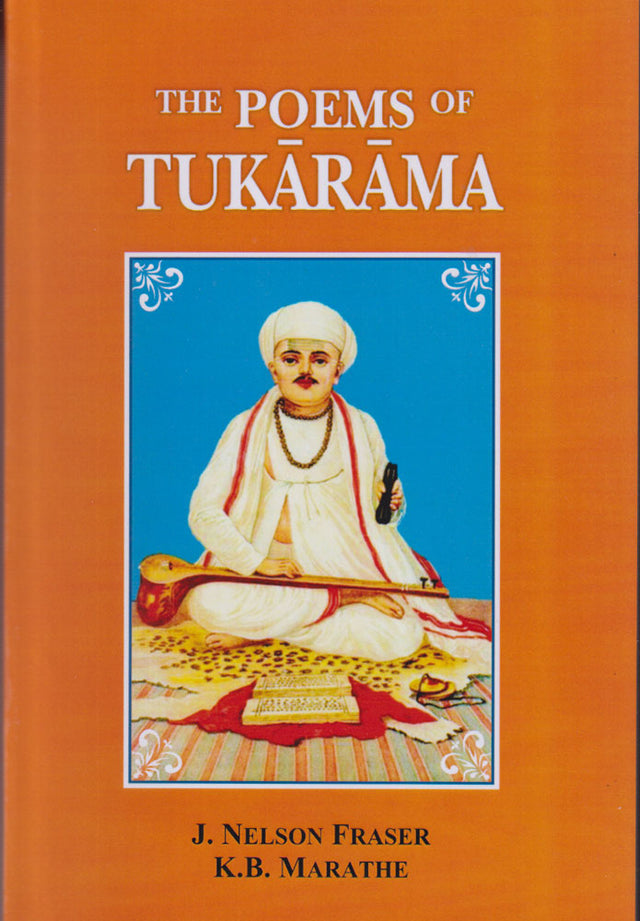The Poems of Tukaram
The Poems of Tukaram - Paperback is backordered and will ship as soon as it is back in stock.
Couldn't load pickup availability
Born in the little village of Dehu, sixteen miles north-west of Poona, probably in the year 1608 A.D., the poet Tukaram was by caste a Sudra and by occupation a corn retailer. After a famine brought distress and bankruptcy, he devoted himself to the family God, Vitthoba of Pandharpura. He soon became a well known teacher, and crowds of people were attracted to his kathas and bhajans. The circumstances of his death are unknown. The popular account states that he ascended into Heaven in the car of Visnu; a note on the Dehu manuscript of his poems says that "Tukoba started on pilgrimage"-and was, apparently, seen no more.
1. The Life of Tukarama: I. Autobiography - (i) Thoughts about the world (ii) Humility, sin, and misery (iii) Prayers (iv) How he awoke (v) His own disqualifications (vi) His motives (vii) The nature of his mission (viii) Appeals (ix) His sense of authority and assurance (x) A prayer for a pupil (xi) Consolation and happiness in God (xii) Admonitions to himself (xiii) Some incidents in his life. II. Descriptions and Invocations III. Pandhari IV. Dehu V. The Nature of God - (i) In Himself (ii) His relation to the world (iii) Union with God necessary (iv) Distinction from God necessary (v) The all-pervading character of God (vi) The universality of God's grace (vii) God's power (viii) The power of God's name (ix) God's generosity and condescension (x) God's protecting love VI. The problem of Action: (i) The perplexing aspect of the world (ii) The impossibility of escaping our past (iii) Nothing is gained by works of law or austerities (iv) Our faith a reward of merit VII. The sense of sin VIII. Remonstrances with god IX. Prayers X. The Conditions of Acceptation XI. The Necessity of Experience XII. Triumphant Happiness XIII. Raillery of God XIV. Faith and Trust XV. The Moral Ideal (i) Purity (ii) Sincerity (iii) Truthfulness (iv) Simplicity (v) Humility (vi) Peacefulness (vii) Perseverance (viii) The service others (ix) General (x) There are few who attain XVI. Life under the influence of religion XVII. Our attitude towards the world - (i) The problem (ii) That we should make the most of it (iii) That we should renounce it XVIII. The Saints - (i) Their character (ii) Their services to men (iii) The insignificance of caste in comparison of virtue XIX. Appeals and Exhortations XX. Rebuke and Admonition - (i) The evil age (ii) The obstinacy of the wicked (iii) Ill-temper and want of charity (iv) Pride (v) Deceit (vi) Greediness (vii) Worldliness (viii) Sensuality (ix) Hypoeritical professions (x) Indifference to religion and churlish conduct to the saints (Various) XXI. True worship- (i) Referring to outward observances (ii) Inner qualities are more than outward observances XXII. The use of images in worship XXIII. False Religious Observances XXIV. Our attitude towards traditional forms of worship XXV. Against false teachers and impostors XXVII. Krishna-(i) His birth (ii) His childhood (iii) His amusements with the cowherds (iv) How they made a meal together (v) How they stole the butter (vi) The condescension implied in his conduct (vii) Various reflections and comments (viii) The passion he inspired in the cowherd damsels (ix) How he stole their clothes while they were bathing XXVIII. In praise of Rama XXIX. Abhangas employing various stories from my thology XXX. Abhangas Employing images from games XXXI. Various village characters XXXII. Abhangas employing the language of common occupations XXXIII. The faithful devotee described under the image of a paik XXXIV. Worldly comforts described under the image of a blanket XXXV. Devotion described under the image of a woman addressing her paramour, Notes, Appendix-I. Proper names, II. Ceremonies and Beliefs Referred to by Tukaram, III. Certain Classifications which are referred to by Tukaram
Â
-
Pages
-
Edition
-
Size
-
Condition
-
Language
-
Weight (kg)
-
Publication Year
-
Country of Origin
-
Territorial Rights
-
Reading Age
-
HSN Code
-
Publisher




